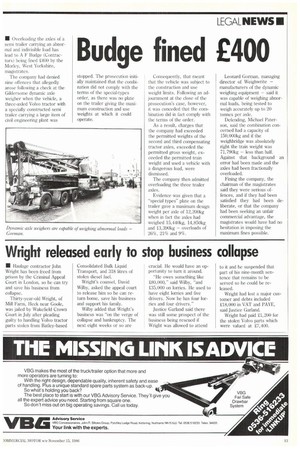Budge fined £400
Page 15

If you've noticed an error in this article please click here to report it so we can fix it.
• Overloading the axles of a semi trailer carrying an abnormal and indivisible load has lead to A F Budge (Contractors) being fined 00 by the Morley, West Yorkshire, magistrates.
The company had denied nine offences that allegedly arose following a check at the Gildersome dynamic axle weigher when the vehicle, a three-ax led Volvo tractor with a specially constructed semi trailer carrying a large item of civil engineering plant was stopped. 'Me prosecution initially maintained that the combination did not comply with the terms of the special-types order, as there was no plate on the trailer giving the maximum construction and use weights at which it could operate. Consequently, that meant that the vehicle was subject to the construction and use weight limits. Following an adjournment at the close of the prosecution's case, however, it was conceded that the combination did in fact comply with the terms of the order.
As a result, charges that the company had exceeded the permitted weights of the second and third compensating tractor axles, exceeded the permitted gross weight, exceeded the permitted train weight and used a vehicle with a dangerous load, were dismissed.
The company then admitted overloading the three trailer axles.
Evidence was given that a "special types" plate on the trailer gave a maximum design weight per axle of 12,200kg when in fact the axles had weighed 15,440kg, 14,850kg and 13,390kg — overloads of 26%, 21% and 9%. Leonard Gorman, managing director of Weighwrite — manufacturers of the dynamic weighing equipment — said it was capable of weighing abnormal loads, being tested to weigh accurately up to 20 tonnes per axle.
Defending, Michael Paterson, said the combination concerned had a capacity of 150,000kg and if the weighbridge was absolutely right the train weight was 71,790kg — less than half. Against that background an error had been made and the axles had been fractionally overloaded.
Fining the company, the chairman of the magistrates said they were serious offences, and if they had been satisfied they had been deliberate, or that the company had been seeking an unfair commercial advantage, the magistrates would have had no hesitation in imposing the maximum fines possible.






























































































